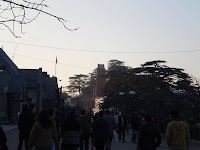'A people without history
Is not redeemed from time, for history is a pattern
Of timeless moments. So, while the light fails
On a winter's afternoon, in a secluded chapel
History is now’
T.S. Eliot
I was listening today to a speech by the Archbishop of Canterbury, Rowan Williams, delivered at Lincoln Cathedral. In this speech he suggested that the church building is a witness of dependability: a place that speaks of a longer time scale and vision than most people work with. Given the way my mind works this of course set me thinking about Shimla and the way that the churches there create a sense of continuity with the past. In my previous post we discussed the way that interactions with heritage buildings give people a sense of rootedness and some of the problems with modernist architecture. It seems to me that the churches are particularly good at this form of Witness even though many of those most involved with them are unaware of this.
In thinking about such things I am reminded of Greenage’s book New Jersey Churchscape, in which he argues that New Jersey (known as the garden city) should really be known as a Churchscape, because the most iconic and eye catching feature of the landscape is the churches. Now, in Shimla as well the churches form a key aspect of the heritage landscape. Christ Church can be seen from virtually every angle on the mall and people are drawn to it.

But it also stands in dialogue with St Andrew’s, the former Scottish Church, which is today the Himachal Pradesh University's centre for evening studies. St Andrew’s Eastern alignment has been cleverly manipulated, by moving the tower to the side, which furthers the sense that the two churches are talking to each other across the expanse of the ridge.

St Michael’s by contrast is more tucked away at Ripon place, yet it is on a key route to the mall from the buss stand and along the mall from IIAS, as such it is something that you stumble upon through the trees, on your way to and from the mall like a hidden gem.

Is Shimla then also a city of Churchscapes? When people walk along the mall are they more drawn to secular buildings, such as Gaity theatre? Or is it the mass of Jakhoo hill, with the unseen presence of the temple atop, that calls to them? Or, are people drawn to the timeless mountains, snow-capped in winter, that tower above Shimla from afar?
If the continuing growth of modern architecture threatens to ruin the landscape of Shimla, is it the old Colonial architecture that makes it? Or, is this also something that intrudes on the true beauty of Shimla, which is the Himalayan peaks and forests?

